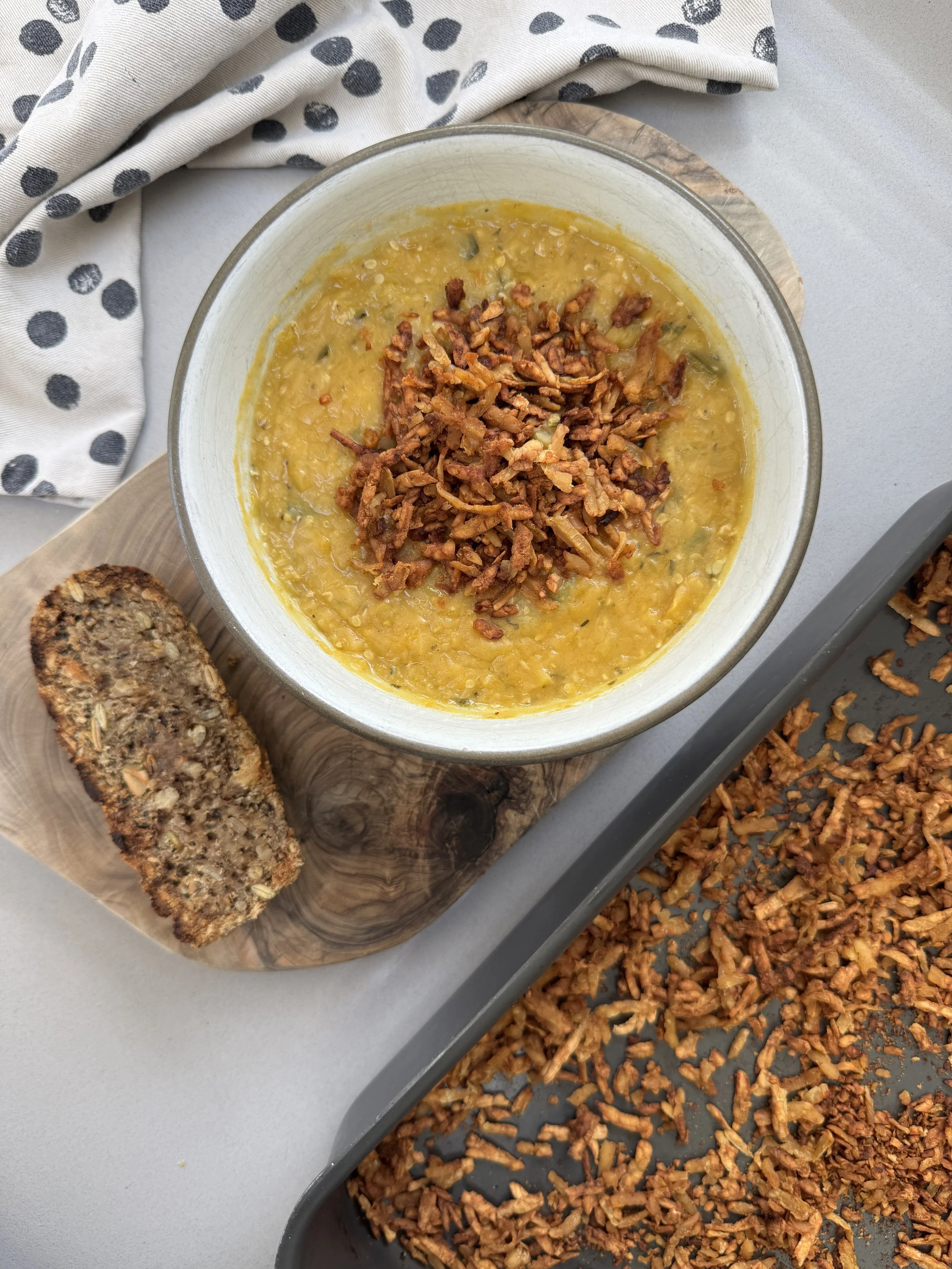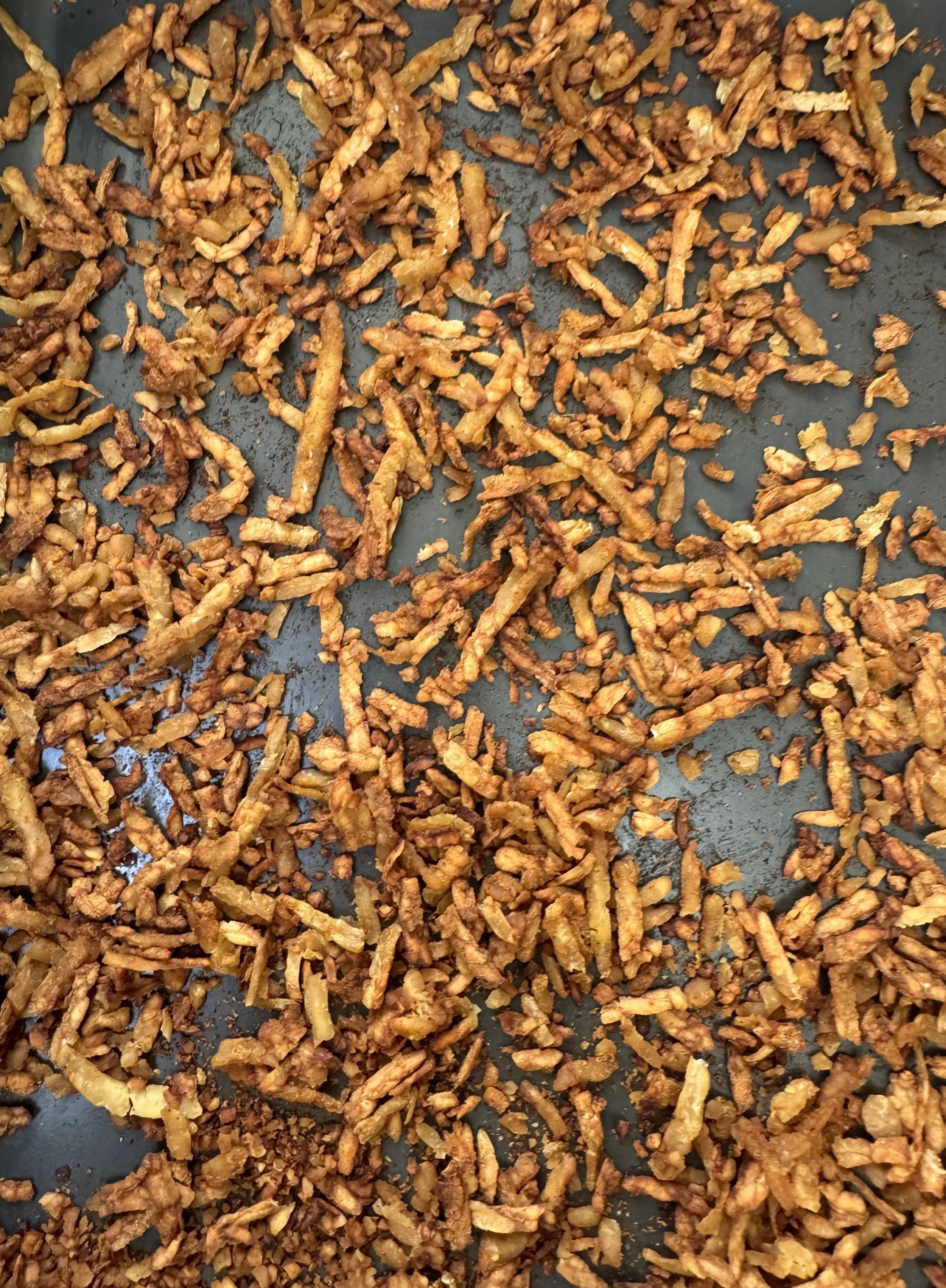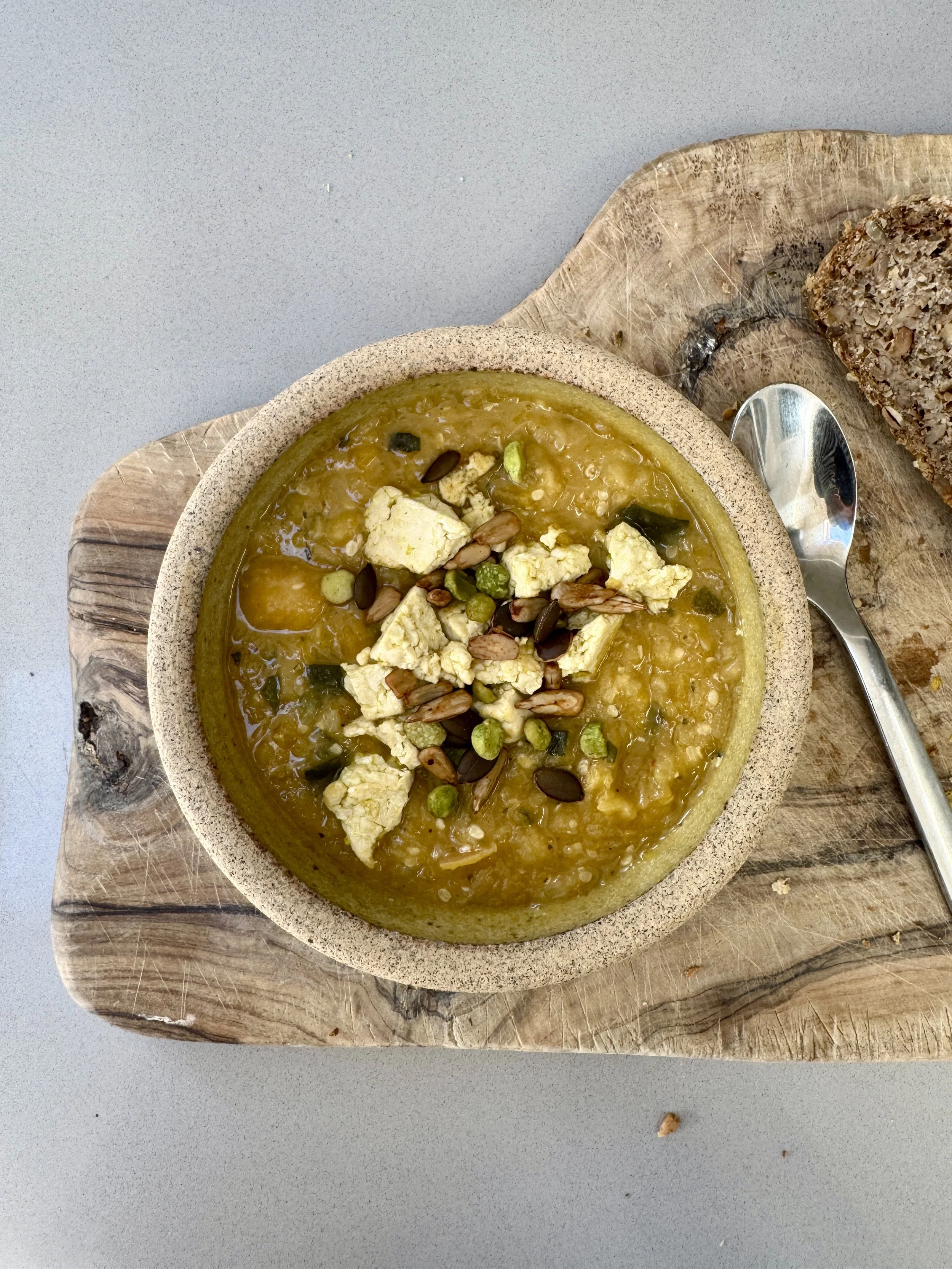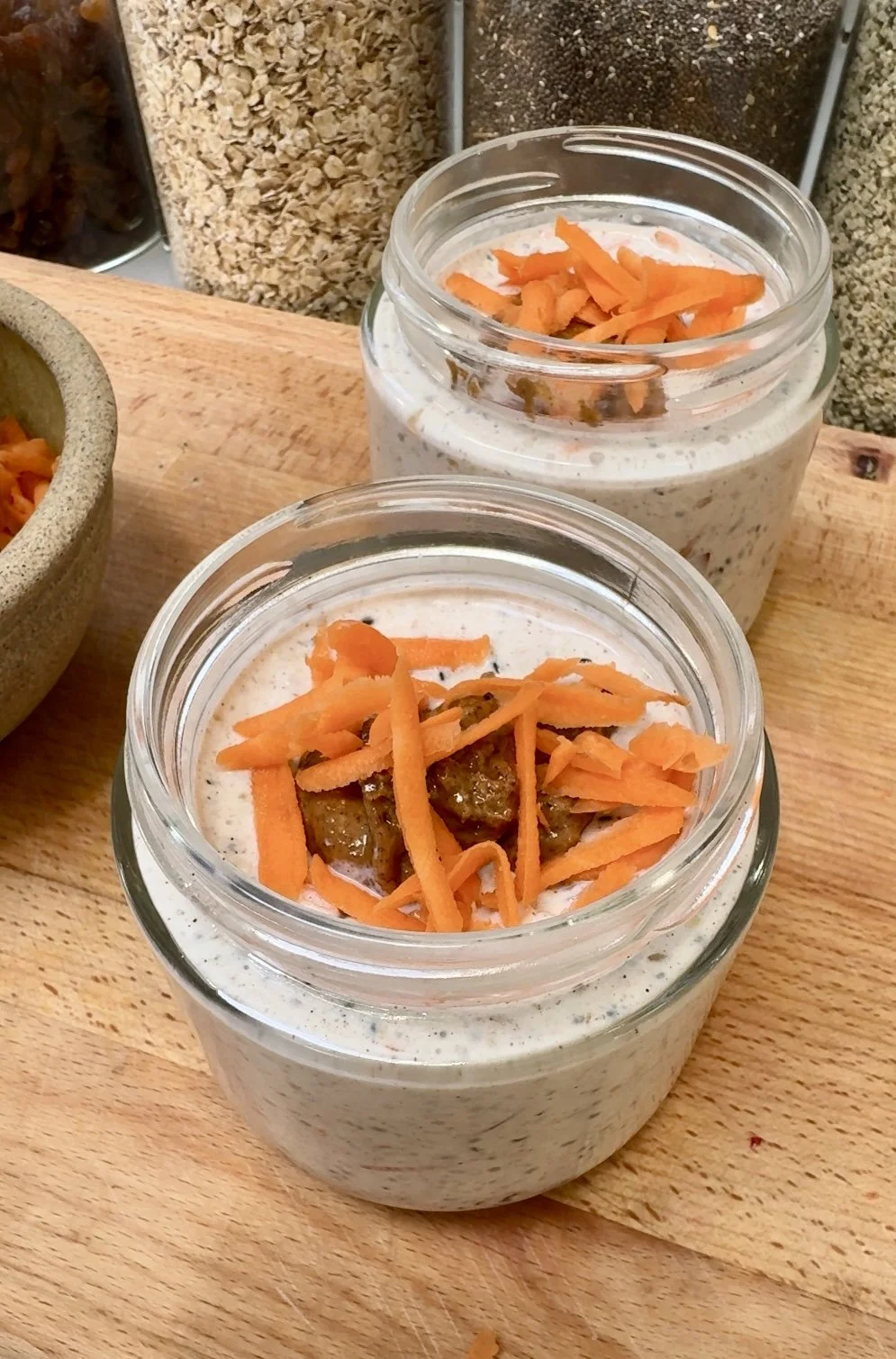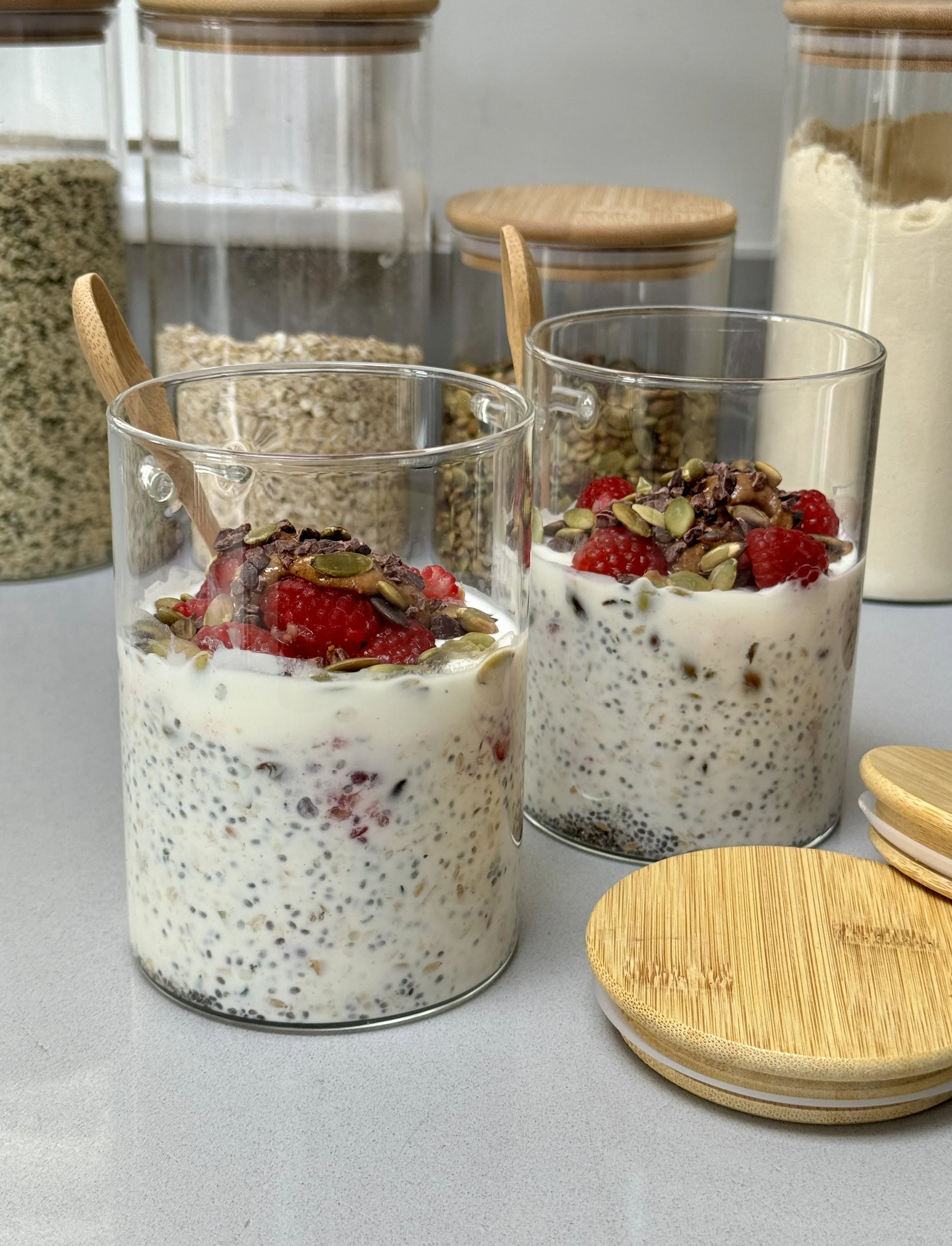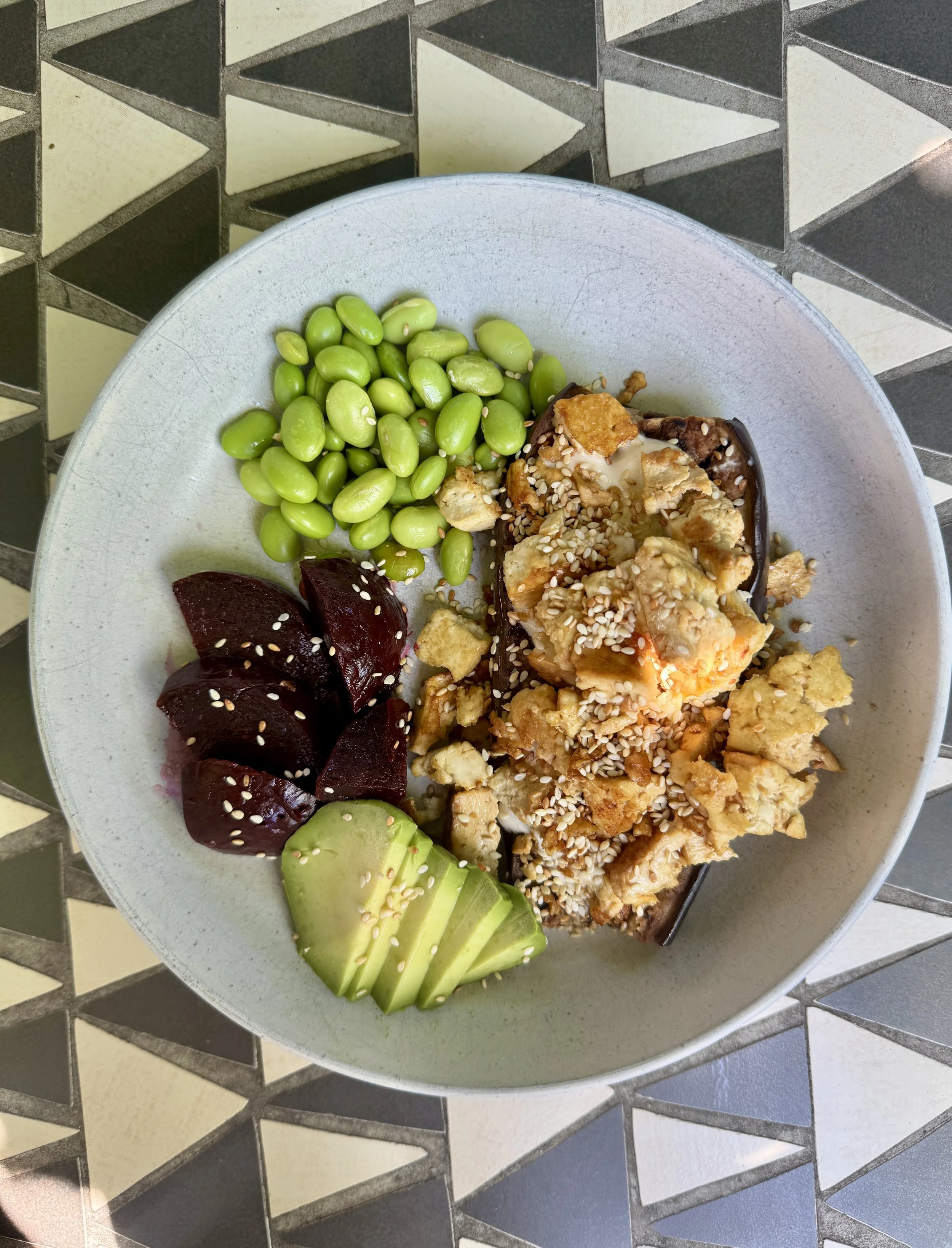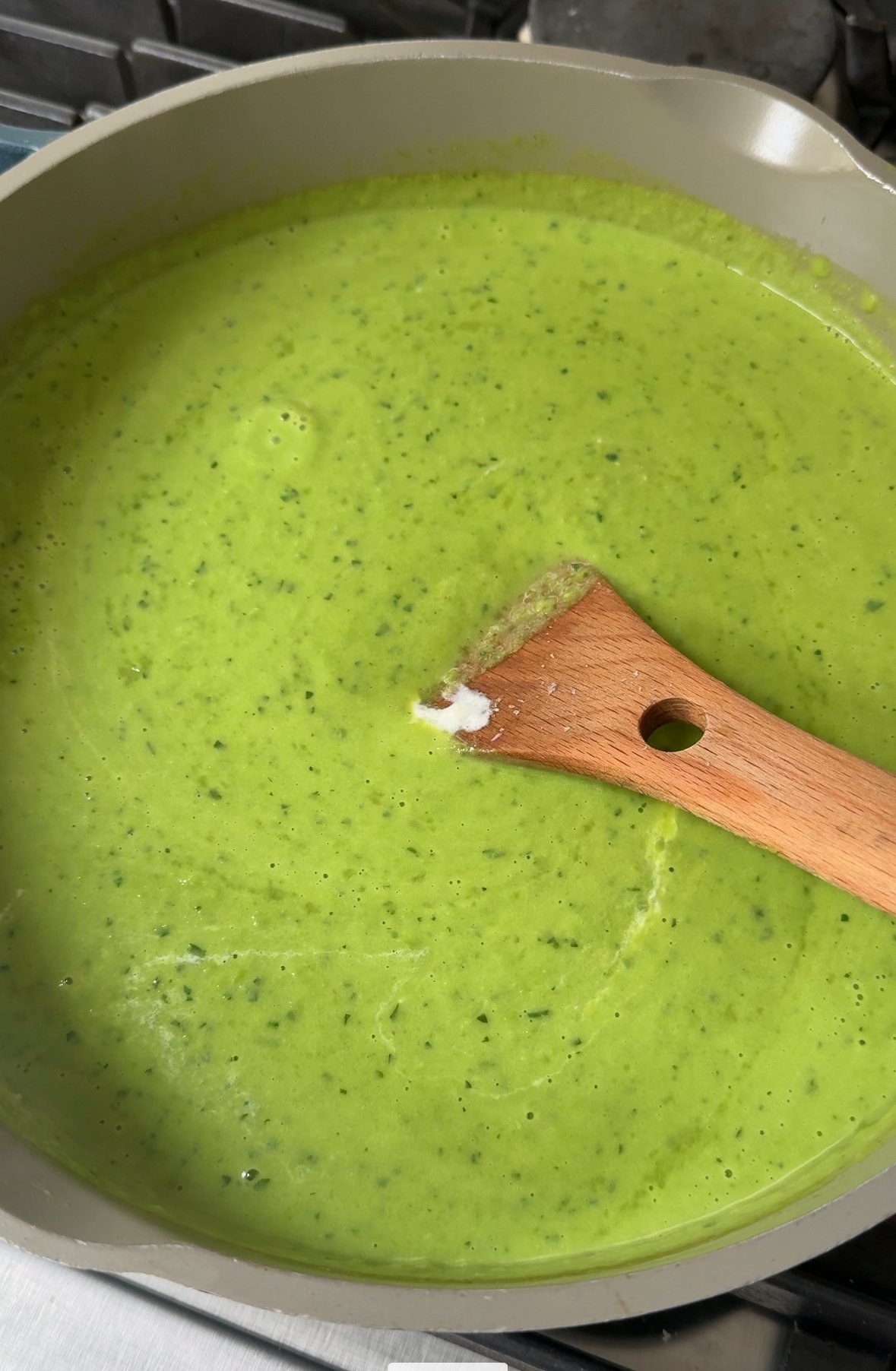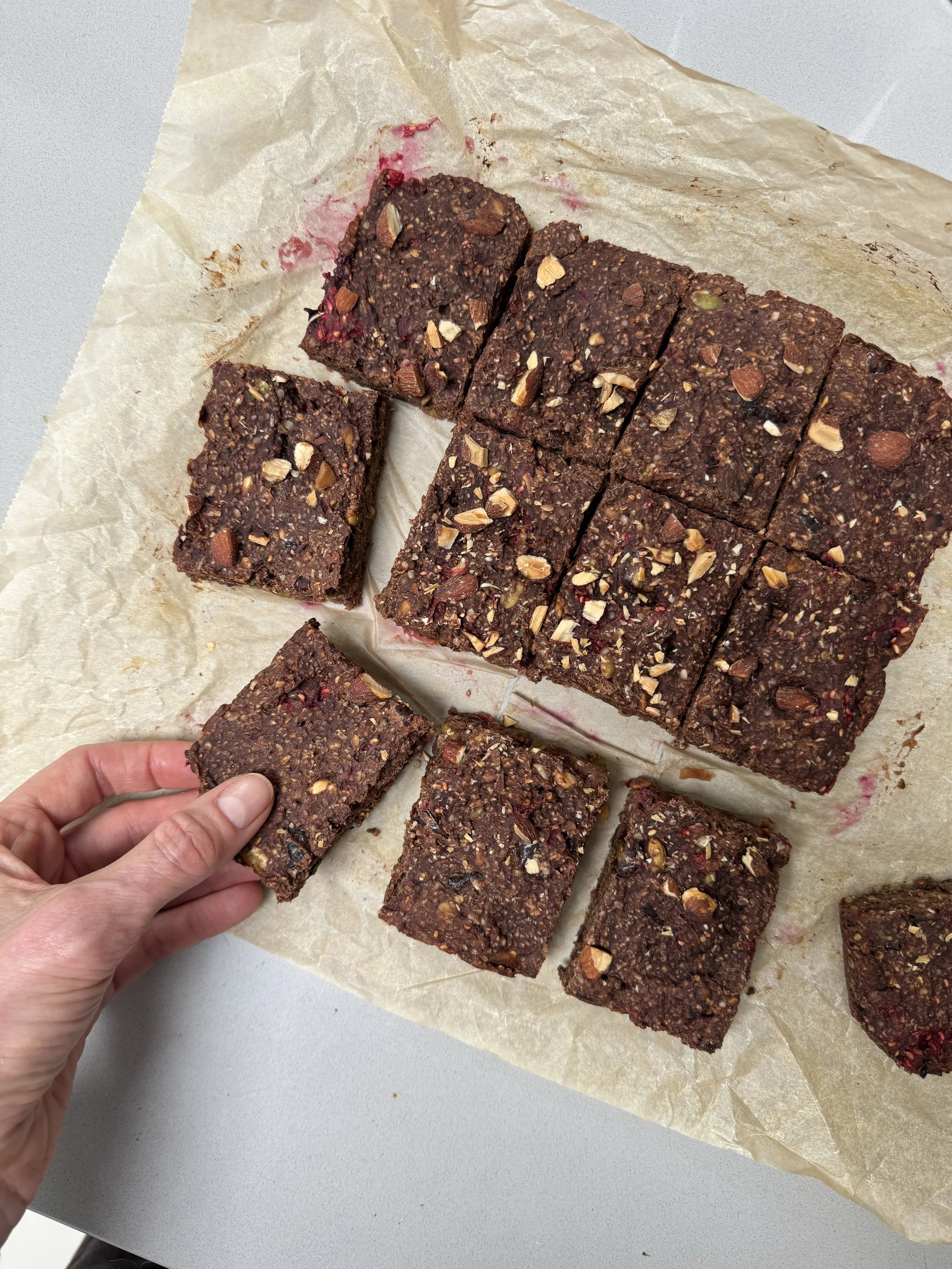Crispy spiced Tempeh
If you’ve not cooked with tempeh before, this is the recipe to start with. Grating and crisping it completely transforms the texture and gives a rich umami falvour, making it really versatile - think of it as a savoury protein crumble you can add to almost anything.
It’s one of my favourite ways to boost protein in meals like soups, roasted vegetables, grain bowls, or salads. It adds flavour, texture, and, most importantly, nutrients.
Nutritionally, tempeh is a standout plant-based protein. It provides around 10 g of protein per 50 g serving, containing all nine essential amino acids, plus iron, zinc, magnesium, and B vitamins that support energy metabolism and the nervous system. Because it’s fermented, it can also be easier to digest than many other soy foods and contains prebiotic compounds that help support a healthy gut environment.
Prep: 10 min | Cook: 10–15 min
Ingredients
Serves 3-4
200 g tempeh (plain, organic if possible)
1 tbsp olive or avocado oil
1 tbsp tamari (or soy sauce)
1 tbsp apple-cider or rice vinegar
1 tsp smoked paprika or ½ tsp smoked + ½ tsp sweet paprika
1 tsp garlic granules or 1 crushed clove
½ tsp ground cumin
A few grinds of black pepper
Method
Preheat the oven to 180°C (fan)Grate the tempeh using the large holes of a box grater, or crumble it finely with your hands.Whisk together the oil, tamari, vinegar, and spices in a bowl.Put the tempeh into a large baking tray, pour over the marinade and toss to coat evenly. Leave for 10 minutes if you can - it helps the flavours absorb, but it will taste great even if you cook straightaway.Spread the tempeh out evenly on the tray and bake for 12–15 minutes, stirring halfway through, until golden and crispy.
Flavour variations
Mediterranean: Add oregano, thyme, tomato purée, and a drizzle of balsamic.
Asian-style: Add grated ginger, sesame oil, and a dash of rice vinegar.
Mexican: Add extra cumin, smoked paprika, and lime juice.
Middle Eastern: Add turmeric, cinnamon, and a spoon of tahini.
How to use
Sprinkle over soups, grain or salad bowls, or roasted vegetables.
Add to omelettes, scrambled tofu, or avocado toast.
Use as a high-protein filling for wraps, tacos, or pasta sauces.
Keeps for up to 4 days in the fridge or can be frozen in portions for easy use.
The tempeh may go softer after being stored in the fridge, but reheating in a frying pan for a couple of minutes will crisp it up again.
Red lentil, Leek, Courgette & Butternut Squash Soup
It’s officially soup season! A warming bowl is perfect for this time of year - easy to prepare, packed with vegetables, and ideal for a healthy lunch at home or work.But many veggie-based soups are lower in protein, which can leave you hungry again a couple of hours later. Adding protein helps turn a light meal into a balanced meal that keeps you feeling full and energised through the afternoon.
Here are a few simple protein-boosting hacks to help you build a more satisfying, nutrient-dense lunch:
Protein-boosting soup hacks:
🥣 Add lentils, chickpeas, or beans while cooking
🤍 Top with fried tofu cubes, cheese (feta, goat’s, cheddar), or cooked chicken
🥄 Swirl in Greek yoghurt or cottage cheese before serving
🌱 Sprinkle hemp seeds, pumpkin seeds, or chopped nuts
🦴 Use bone broth or stir in unflavoured collagen
🍞 Serve with a slice of high-protein bread and a topping such as egg, salmon, or hummus
Small tweaks make a big difference — steadier energy, fewer cravings, and a healthy lunch that actually keeps you going ✨
Ingredients
Serves: 6 | Prep: 10–15 min | Cook: 25–30 min
1 tbsp olive or rapeseed oil
1 leek, trimmed and sliced
2 garlic cloves, finely chopped
2 sticks celery, chopped, or ½ tsp celery salt
1 courgette, diced
½ medium butternut squash (~400 g), peeled and diced
1 tsp ground cumin
1 tsp paprika (optional)
180 g red lentils, rinsed
1.3 L vegetable stock (or bone broth for extra protein)
4 tbsp (40 g) shelled hemp seeds
1 bay leaf
1-2 tbsp apple cider vinegar
Sea salt & black pepper, to taste
Fresh parsley or coriander, to serve
Method
Warm the oil in a large saucepan. Add leek and celery; cook gently for 5–7 minutes until soft but not browned. Stir in garlic, cumin, and paprika (and celery salt if using instead of celery) for another minute.
Add courgette and butternut squash. Cook for 5 minutes, stirring occasionally, to start softening.
Stir in lentils, hemp seeds, bay leaf and stock. Bring to a boil, then reduce heat and simmer for 25–30 minutes, stirring occasionally, until the lentils and vegetables are tender.
Lightly mash some of the vegetables and lentils to thicken slightly while keeping chunks for texture.
Stir in apple cider vinegar, season generously, and garnish with herbs.
Approximate Nutrition (per serving, 1/6 of recipe)
Calories: ~255 kcal Protein: ~12.5 g Fibre: ~7.5 g Carbohydrates: ~27 g Fat: ~8 g
Topped with tofu, pumpkin seeds, and served with a slice of high-protein bread
Protein : ~32.5 g
Carrot cake breakfast pots
Why a high-protein, high-fibre breakfast matters
Starting the day with a balanced meal that’s rich in protein and fibre helps to set up your metabolism, appetite, and energy levels for the rest of the day. Protein slows digestion and supports the release of satiety hormones such as GLP-1 and PYY, helping you feel fuller for longer and less likely to reach for snacks mid-morning. Fibre further stabilises this effect by slowing glucose absorption and supporting a steady blood-sugar response, which means fewer energy dips and cravings later on. Together, they promote sustained concentration and energy, while providing key nutrients for muscle repair, gut health, and hormone production.
For women in midlife, this combination becomes particularly important. As oestrogen levels fluctuate and eventually decline, the body’s ability to maintain muscle mass, insulin sensitivity, and appetite regulation naturally decreases. A protein-rich breakfast helps counter these shifts by supporting lean tissue and metabolic health, while fibre nourishes the gut microbiome, which in turn influences inflammation, oestrogen metabolism, and mood. In short, a high-protein, high-fibre breakfast is one of the simplest ways to steady hormones, support energy, and keep you feeling balanced through the day.
Ingredients
Protein: ~27 g Fibre: ~11 g
Ingredients
Serves 1
1 tbsp rolled oats
½ tbsp chia seeds
½ tbsp ground flaxseed
2 tbsp shelled hemp seeds
1 tbsp pumpkin seeds
100 g high-protein Greek yoghurt
6 tbsp unsweetened nut, coconut or cow’s milk (e.g. Plenish)
30 g apple, finely chopped
30 g carrot, grated
1 tbsp sultanas
Topping
½ tbsp almond butter
1 tsp cacao nibs, chopped nuts or desiccated coconut
Method
In a bowl or jar, combine the oats, chia, flax, hemp, and pumpkin seeds.
Add the Greek yoghurt and milk, alternating small amounts of each while stirring until you have a thick, even mixture.
Fold through the apple, carrot, and sultanas.
Cover and refrigerate overnight (or for at least 2 hours) to allow the chia and oats to soften.
Add the toppings or leave until you are ready to eat.
Raspberry breakfast pots
This tasty, nutrient-packed breakfast is a morning win! Ready to eat at home or take to work, it’s packed with around 28 g protein and 14 g fibre to keep you full and energised until lunchtime.
A high-protein, high-fibre start helps keep blood sugar steady, which can mean fewer cravings, more consistent energy and better appetite control all day long.
Why it matters (especially for women 35+):
🔹 Hormone support & satiety - It can get harder to regulate blood sugar as we get older, so a protein-rich breakfast helps steady levels and reduce mid-morning cravings.
🔹 Muscle & metabolism - Protein first thing supports lean muscle, which naturally declines from age 30, and especially during perimenopause/menopause.
🔹 Grab-and-go - Make it the night before, and it’s ready to eat or take to work. No more feeling starving by 11 after grabbing a slice of toast or a bowl of cornflakes.
Ingredients
1 tbsp rolled oats
1 tbsp chia seeds
2 tbsp shelled hemp seeds
½ tbsp pumpkin seeds
100 g high-protein Greek-style yoghurt (*Fage)
3 tbsp unsweetened almond or coconut milk
Small handful chopped pear
Small handful of raspberries, lightly squashed (save 2–3 whole to top)
Topping
½ tbsp almond butter
Pinch of pumpkin seeds and a few cacao nibs (optional)
Method
Combine the dry ingredients in a jar or small bowl.
Stir in the yoghurt, then the milk until everything is well coated.
Fold in the pear and raspberries (or add just before serving if you prefer them on top).
Top with the almond butter and a sprinkle of pumpkin seeds or cacao nibs (or add in the morning if you have time).
Cover and refrigerate overnight.
Tip
Protein-boosting - if you’re using Greek-style yoghurt with less than 10 g protein/100 g, stir in 1 tbsp (~8 g) whey protein powder /100 g yoghurt.
Batch prep - make 5x this recipe in a larger container for a ready-to-go healthy breakfast all week.
Creamy Miso Aubergine with Tempeh & Tahini Yoghurt
This recipe is a perfect example of how a plant-based meal can be deeply satisfying, nutritionally balanced, and full of flavour. Rich in protein, fibre, healthy fats, and complex carbohydrates, it also delivers key nutrients that support energy, hormone balance, and long-lasting fullness.
Each serving provides approximately 35g of protein, nearly 20g of fibre (daily target is 30g!!), and six diverse plant points, even without the optional quinoa or rice. It contains phytoestrogen-rich ingredients like tofu, tempeh, and edamame, which may help with hormonal balance, whilst fermented tempeh may support gut health. The combination of tahini, miso and leafy greens delivers magnesium, calcium and iron – all essential for bone health, blood sugar balance and mood.
The recipe came about by accident – a test batch that turned into 4 portions I ended up eating all week! Normally I get bored of eating the same thing, but not this time. It’s that good – creamy, savoury, and incredibly satisfying! Originally made with grated, oven-roasted tempeh, I swapped in crumbled tofu today, pan-fried with olive oil and tamari, and it was super nice as well (see note at the bottom for alternative instructions).Ingredients
Serves 4
Marinade:
1 tbsp miso paste2 tbsp boiling water1 garlic clove, gratedThumbnail sized piece fresh ginger, grated (I use a Microplane – also great for garlic)1 tbsp tamari or soy sauce3 tbsp waterMain:
2 aubergines, halved lengthways1–2 tbsp sesame oil400g tempeh, grated½ tbsp sesame oil½ tbsp tamari or soy sauceTahini dressing:
3 tbsp tahini4 tbsp Greek yoghurt1–2 tbsp waterJuice of 1 small lemon½ garlic clove, finely gratedPinch sea saltTo serve:
½ head broccoli, steamed½ spring cabbage, shredded & steamed320g shelled frozen edamame, defrostedOptional: cooked quinoa or brown rice
Method
1. Preheat oven to 180°C (fan)
Take edamame out to defrost in a bowl.2. Make marinade
Mix miso paste with boiling water until smooth. Add garlic, ginger, tamari, and water.3. Prepare aubergines
Score the flesh in a deep criss-cross pattern (avoid piercing the skin). Rub with sesame oil and place cut-side up on a lined baking tray. Pour the marinade over each half. Roast for ~45 minutes until soft and caramelised.4. Roast tempeh
Spread out on a baking tray. Drizzle with sesame oil and tamari. Add to the oven once the aubergines have had about 25 minutes, and roast for 15–20 minutes until golden and starting to crisp.5. Make dressing
Whisk together tahini, yoghurt, lemon juice, garlic, salt, and enough water to make a smooth, spoonable consistency.6. Steam veg
Steam broccoli, cabbage, and edamame until just tender.7. Plate up
Serve each aubergine half topped with tahini yoghurt and crispy tempeh. Add steamed greens and edamame on the side. Include quinoa or rice if using.Tofu Option
How to:
Crumble 400g firm tofu into chunky pieces using your fingers (about the size of chickpeas).
Heat a drizzle of olive oil in a non-stick frying pan.
Add the tofu in batches and fry for 3–4 minutes, turning occasionally until lightly golden.
Splash in 1 tsp soy sauce or tamari, stir for another minute to coat and warm through.
Creamy tomato butterbeans
A simple, hearty dish that brings out the best in butter beans with slow-cooked onions and a flavourful tomato base. So much tastier than baked beans and you can just sue them in the same say - on sourdough toast with cheese, or they're great as part of a cooked breakfast.Ingredients
Serves 4 as a side
1 large onion, halved and thinly sliced into half-moons
1 garlic clove, finely grated or chopped
1 x 700g jar Bold Beans butter beans (or two tins), including the bean water/stock
½ tsp dried oregano
1 tsp paprika
1.5 tbsp double concentrate tomato purée
½ tsp sea salt
A crack of black pepper
Method
Heat a generous drizzle of olive oil in a large pan over low heat. Add the onions and cook slowly for about 20 minutes until soft and caramelised.
Stir in the garlic and cook for another couple of minutes until fragrant.
Sprinkle in the oregano and paprika, stirring for a few seconds to release their aroma.
Tip in the butter beans along with their water/stock, then stir in the tomato purée.
Simmer gently for 15 minutes, allowing the flavours to meld together.
Season with sea salt and a crack of black pepper to taste.
baked Cod with butterbeans
This is a satisfying, healthy meal that’s full of flavour, and packed with nutrients. Cod is a lean, high-protein fish with omega-3 fatty acids that help to reduce inflammation, and support brain and heart health. Plus, cod is a good source of essential minerals like selenium, which boosts immune function and protects cells from oxidative stress.The butterbeans in this recipe provide plenty of plant-based protein and fibre, helping to stabilise blood sugar levels and keep you feeling satisfied. They’re also a great source of folate, magnesium, and iron - nutrients vital for energy production and supporting a healthy nervous system.
Tomatoes provide a healthy dose of vitamin C and lycopene, a powerful antioxidant that promotes skin health and reduces the risk of certain cancers. The crispy breadcrumb topping with parmesan adds extra flavour, and rosemary is a natural anti-inflammatory herb that’s great for digestion.
Ingredients
Serves 4
1 small red onion, chopped finely
1 large garlic clove, grated or chopped finely
1 tsp sweet smoked paprika
1 tsp ground fennel seeds
1 x 400g tin butterbeans
1x 400g tin chopped tomatoes
¾ tsp sea salt
Topping
30g sourdough breadcrumbs
10g parmesan cheese, grated finely
½ tsp fresh rosemary, chopped
Method
Preheat the oven to 200°C (180°C fan) / 400°F / Gas mark 6.
Heat a little olive oil in a large ovenproof pan over medium heat. Add the finely chopped red onion and garlic, and sauté for 10 minutes until softened.
Stir in the smoked paprika and ground fennel seeds, cooking for 1 minute.
Pour in the tin of butterbeans (including the liquid) and the chopped tomatoes. Add the sea salt and stir everything together. Allow the sauce to simmer on the hob for 15 minutes, stirring occasionally, until it thickens slightly.
While the sauce is simmering, combine the sourdough breadcrumbs, grated parmesan cheese, and chopped rosemary in a small bowl and set aside.
Nestle the cod fillets into the tomato and butterbean sauce, ensuring they are partially submerged. Sprinkle the cod with a pinch of salt and a drizzle of olive oil.
Use a spoon to spread the breadcrumb and parmesan mixture evenly over the cod fillets.
Transfer the pan to the preheated oven and bake for 20 minutes, until the cod is cooked and flakes easily with a fork, and the topping is golden and crispy.
Garnished with fresh herbs and serve with roast potatoes, wholegrain cous cous, or brown basmati rice with steamed/roasted broccoli, or leafy greens. Or even just a green salad for a lighter meal.
AUbergine, pepper & lentil curry
This aubergine & lentil coconut curry is a nutrient-packed meal that may help support your immune system, perfect for the back-to-school season.
With fibre-rich veggies, plant-based protein, & healthy fats, this dish can help support digestion & gut health—key for a strong immune system. Red lentils provide a great source of protein & iron, important for energy & muscle function, while their slow-release carbs help keep blood sugar steady.
Turmeric & cumin give more than just flavour; their anti-inflammatory & antioxidant properties, particularly from curcumin, add extra benefits. Coconut milk brings healthy fats, including MCTs, which are easily absorbed for energy. & don’t forget the coriander & lime yoghurt—packed with vitamin C & probiotics to further support your gut & immune health. This curry is a simple, tasty way to nourish your body & could help strengthen your defences against everyday bugs.
Ingredients
Serves 4
1 aubergine, chopped into 2cm chunks
1 red onion, sliced into thin half-moons
1 red pepper, chopped
1 large garlic clove, finely chopped or grated
1 thumb-sized piece of ginger, finely grated (I use a Microplane)
1.5 tsp cumin seeds
½ tsp ground turmeric
½ tsp dried chilli flakes
100g red lentils, rinsed well and drained
1 tin (400ml) coconut milk
1 tin (400g) chopped tomatoes
1 tsp sea salt
Coriander & Lime Yoghurt:
6 heaped tbsp Greek or coconut yoghurt
Juice of 1 lime
1 tbsp chopped coriander leaves
Method
Preheat the oven to 180°C. Place the aubergine on a baking tray, drizzle with olive oil, and roast for 20 minutes until softened and lightly browned.
Heat a glug of olive oil or ½ tbsp coconut oil in a large pan over medium heat. Add the onion & cook gently for 10 minutes, stirring occasionally.
Add the red pepper & cook for another 8 minutes.
Add the garlic and ginger to the pan and cook for 1 minute. Stir in the cumin seeds, turmeric, and chilli flakes, and cook for 30 seconds to release the flavours.
Add the lentils, coconut milk, and chopped tomatoes to the pan and stir well. Add the roasted aubergine, cover with a lid, and simmer for 20 minutes on low heat.
Mix the Greek yoghurt with lime juice, chopped coriander, and a pinch of salt in a small bowl.
Serve with basmati rice and a spoonful of yoghurt on top.
creamy green pea pasta
Here’s a gorgeous vibrant green pasta with a fresh delicate flavour and lots of the good stuff! Green peas have a delicious sweet flavour and work really well with fresh herbs such as parsley or basil. I’ve have added some optional marscapone cheese for extra creaminess, but you can just add parmesan if you prefer as the peas have a naturally creamy flavour when pureed anyway. I also used fresh chicken stock to boost protein and flavour, but a good vegetable stock, preferably fresh, would also be great. And if you want to make the sauce plant based, you can leave out the dairy and add some fried firm tofu, or top with cashew nuts.
Peas are a great source of vitamin C (around 66% of your RDA in 100g), and protein (5g per 100g), which may be important for supporting your immune system, collagen formation and wound healing. This sauce is also high in fibre, especially if you use wholemeal, lentil or spelt pasta, to keep your gut microbes happy.
ingredients
Serves 4
½ tbsp extra virgin olive oil
Large knob of butter
1 large onion, chopped finely
1 large garlic clove, grated finely
500g frozen peas
500ml chicken or vegetable stock
Handful of fresh parsley or basil, or both!
3 tbsp mascarpone cheese, optional
2 handfuls of grated parmesan
Good pinch of salt and grind of black pepper
Squeeze of lemon
Pasta: which ever kind you prefer!
method
Heat the olive oil and butter in a large saucepan and then fry the onions gently for around 15 minutes until browned.Next add the garlic and fry for a minute before adding the frozen peas.
Start cooking the pasta now.
Pour in the stock and simmer for 5 minutes.
Add the herbs and then blitz the sauce with a hand blender.
Add the mascarpone if you’re using it, and stir well.
Put in the parmesan, salt, and pepper and stir.
Add the drained pasta to the sauce and serve with a squeeze of lemon, extra parmesan and a drizzle of olive oil.
High protein chia & flax bread
I love this bread because it’s so tasty and incredibly good for you, with lots of protein, fibre, and healthy fats. Here, I’ve adapted the original recipe a bit by using 50:50 chia and flax, plus sunflower and pumpkin seeds to add a lovely nutty crunch and flavour.
Most shop-bought gluten-free bread is full of additives, so if you’re looking for an easy home bake option, then this is a great recipe. The best thing about it is that it’s a no-rise method; all you have to do is mix all the ingredients together, scrape into a tin, and bake. It literally takes 5 minutes.
This bread is a great source of protein from all the seeds, plus it’s made with 6 eggs. It’s also high in fibre, anti-inflammatory omega-3 fatty acids, and various vitamins and minerals like calcium, magnesium, and phosphorus, which keep your muscles, nerves, and bones healthy!
It’s great topped with nut butter and slices of apple or banana for breakfast, and it works really well with savoury toppings, too, like mashed avocado, roasted tomatoes, smoked salmon, houmous, or feta.
Ingredients
115g / 1 cup chia seed
115g / 1 cup flaxseed
½ cup mixed toasted seeds
1 tbsp baking powder
6 large eggs
130ml / ½ cup water
50ml olive oil
½ tsp sea salt
Method
Preheat the oven to 175°c.Line a 2lb loaf tin with parchment (you can buy shaped loaf tin liners from Sainburys).
Put all the ingredients in a large bowl and mix well with a whisk.
Scrape the mix into the lined tin, and top with the remaining toasted seeds and a sprinkle of sea salt.
Place in the oven for 40 minutes. Check that the loaf is cooked by making sure a skewer comes out clean.
Keeps in an airtight container for 5-7 days.
teriyaki Salmon with noodles
I've been meaning to write up this recipe for ages, as it’s such a staple in our house. It's a great dish popular with kids and adults alike, as everyone can pick and choose the bits they want and leave out things they don’t. It's great for fussy eaters!
I’ve made the recipe as straightforward as possible, so it doesn’t take long to prep. There’s lots of flavour, protein, fibre (veggies), and the salmon is full of healthy omega-3 fats in the form of EPA (eicosapentaenoic acid) and DHA (docosahexaenoic acid).
Omega-3 fats:
They are anti-inflammatory and essential for maintaining overall health. Chronic inflammation is linked to various health conditions, including heart disease, arthritis, and autoimmune disorders. Omega-3s may also support immune function by enhancing the activity of immune cells.
Vital for brain function and development. They are a key component of cell membranes in the brain and help support cognitive function, memory, and overall mental health. Some studies suggest that omega-3s may also reduce the risk of age-related cognitive decline and Alzheimer's disease. They also play a role in neurotransmitter production, the chemicals that send signals in our brain, such as serotonin, dopamine, and adrenalin, which regulate mood.
Support heart health by reducing the risk of heart disease. They can help lower triglycerides, reduce blood pressure, prevent plaque buildup in arteries, and decrease the risk of abnormal heart rhythms.
Reduce joint pain and stiffness by helping to decrease inflammation and may improve overall joint function, particularly in those with rheumatoid arthritis and other inflammatory conditions.
Maintain the integrity and barrier function of the skin. Omega 3s can help reduce inflammation associated with skin conditions like acne, eczema, and psoriasis and may also promote wound healing.
Oily fish such as salmon, mackerel, sardines, and herring contain the highest levels of omega-3 fatty acids, and the NHS recommends eating at least one portion of them a week, plus a portion of non-oily fish. There are also vegan sources of omega-3s, including flaxseed, chia seeds, hemp seeds, and walnuts, but they are in the less bioavailable form of alpha-linolenic acid (ALA).
Ingredients
Serves 4Marinade
¾ tbsp sesame oil
6 tbsp soy sauce
1 tbsp rice wine vinegar
¾ tbsp mirin or runny honey
4 salmon fillets, skin on
300g medium fine noodles (I like wholewheat or buckwheat)
2 garlic cloves, finely chopped or grated
1 thumb of fresh ginger, finely grated
1/3 cucumber, chopped in fine sticks
6 radishes, chopped finely
150g tenderstem broccoli
200g baby corn
90g baby pak choi
1-2 tbsp rice or white wine vinegar
Optional: toasted sesame seeds or finely chopped spring onion
Method
Mix the marinade ingredients in a large dish large enough to hold the salmon in one layer, skin side up.
Preheat the oven to 180ºc.
Place the salmon in the dish and rotate to cover all sides in marinade. Set aside for 10-30 mins (max 45 minutes).
Place a sheet of parchment on a baking tray and spread out the salmon skin side down, allowing the excess marinade to drip back into the dish.
Put the salmon in the oven for 12 minutes.
Put the cucumber and radishes in a small bowl and pour over the vinegar
Boil a kettle so you have water to steam the veggies and cook the noodles.
After the salmon has been cooking for 5 minutes, steam the vegetables for 5-6 minutes until tender.
Cook the noodles in boiling water per the instructions (usually 5 minutes, but 2 if fresh).
Drain the noodles and rinse them in cold water to prevent sticking.
Warm your bowls in the oven for a few minutes.
Add the remaining marinade, plus 200ml of water, to the same pan you used for the noodles, heat quickly, and simmer for 3-4 minutes, then add the noodles, stirring well to coat.
Divide the noodles, steamed veggies, and salmon into bowls, along with a bundle of cucumber sticks and radish slices (drain off excess vinegar first).
Optional: top with toasted sesame seeds or spring onion.
Tip
You can use any combo of steamed veg that you like; choose three different types eg. carrots, mangetout, sugar snap peas, kale, green beans, courgettes, cavolo nero,
I prefer to steam the veggies, as they give the dish a fresher crunch than fried, but you can fry them in sesame oil if you prefer.
I sued buckwheat noodles, but switch or standard egg noodles or any kind of rice that you like - sticky, white, or brown.
rich umami chicken casserole
A lovely dish at this time of year when it’s still cold, and you want something comforting to eat that is full of umami flavor: that deep satisfying savoury taste you almost can’t put your finger on! Apparently, umami taste receptors are found on the tongue and are sensitive to the presence of glutamate, which is an amino acid commonly found in foods such as meat and stocks, fish, vegetables (especially tomatoes and mushrooms), and aged or fermented products like cheese and soy sauce.
This is chicken casserole on steroids as I’ve maxxed the flavour using a really rich chicken stock (recipe here), lots of veggies, and good-quality chicken. If you have the time, it’s really worth making your own stock and using a couple of carcasses will really boost the flavour and protein content—you can buy them from the butchers or save them from a roast and freeze them until you have two.
This is an easy hand-off recipe that won’t take long to prep, just a bit of chopping and then you basically just throw everything in. Great for a chilly evening or weekend lunch.
Ingredients
Serves 4
4 large chicken breasts, diced
1 large onion, sliced in half moons
2 large garlic cloves, finely grated or chopped
2 sticks celery, small dice
3 large carrots, chopped
2 ½ heaped tbsp spelt flour (or wheat if you prefer)
1 tsp dried oregano
1 bay leaf
1 litre fresh chicken stock
2 large handfuls of chopped greens (spring greens, savoy cabbage, kale, spinach)
2 leeks, chopped
1 tbsp apple cider or white wine vinegar
1 tsp salt
Black pepper
Method
First, make the stock, drain, and set aside to cool (refrigerate after two hours max) - this can be done a couple of days before or in the morning if you can leave it bubbling away at the weekend or even while you work at home.
Add a good glug of olive oil to a casserole and brown the chicken in batches so it doesn’t bubble and steam. Set aside in a bowl.
Add a tablespoon of olive oil to the casserole and gently fry the onions for 10-15 minutes until soft.
Next, add the celery and carrots for 5 minutes before adding the garlic for a minute or two.
Add the flour, oregano, bay leaf, and chicken, and mix well.
Slowly pour in the chicken stock, stirring well with each addition to avoid getting floury lumps.
Simmer for 15 minutes, and then add the leaks for 10 minutes.
Next, add whatever greens you’re using for 5 minutes. Finish with the vinegar and cook for a couple of minutes before adding the salt, and pepper.
Serve with sweet potato or ‘normal’ mash, brown rice, roasted celeriac or squash, and green veg (broccoli, peas, green beans).
Berry power smoothie
If you’re a regular on my blog, you’ll know that I love a smoothie for breakfast. Today I threw together berries and nuts with creamy oat milk and added protein powder to keep me going until lunch. I always use frozen fruit as it’s so much cheaper and works better in a smoothie as it naturally chills the drink without the need for ice.
Ingredients
Protein: ~27–29 g
Fibre: ~8–9 g
Serves 1
30g strawberries
30g blueberries
30g raspberries
1 tbsp chia seeds
1 tbsp almond butter
2 tbsp organic whey or pea protein (to provide ~20 g protein)
200 ml nut milk (I like Plenish drinks)
Method
Blitz!
Filter by Tag
- aubergine
- Dark chocolate
- beans
- breakfast
- Middle Eastern
- Moroccan
- almond
- blueberry
- BBQ
- Mexican
- Spice blend
- basil
- asparagus
- blueberries
- Prawns
- Thai
- Blog
- Breakfast
- Topping
- Winter
- bone broth
- Nutrition
- black beans
- Christmas
- French
- Spanish
- banana
- apricot
- Italian
- avocado
- almonds
- banana bread
- biscuits
- adzuki beans
- Indian
- bologese
- beetroot
- Asian
- Sweet potato
- Yorkshire
- Yorkshire puddings
- Ottolenghi
- bread
- Honey & Co
- asian
- Nigella Lawson
- bake
- Meera Sodha
- Lepard
- baking

